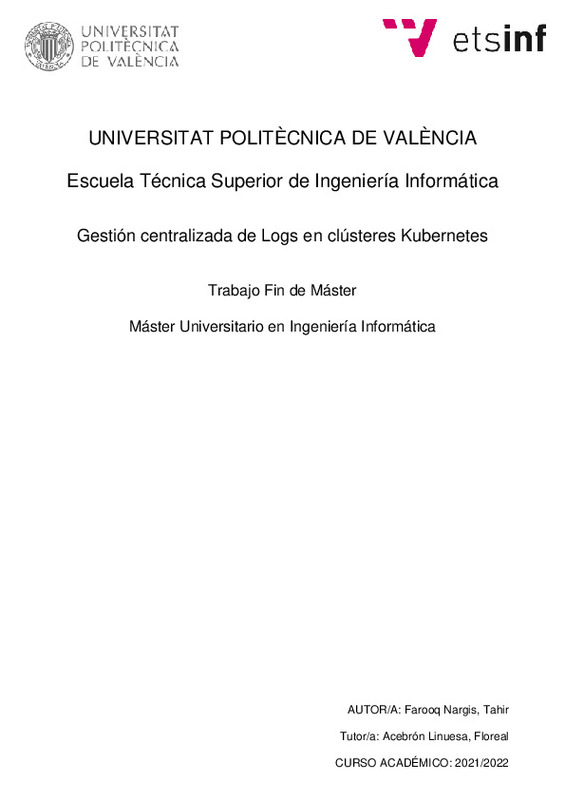JavaScript is disabled for your browser. Some features of this site may not work without it.
Buscar en RiuNet
Listar
Mi cuenta
Estadísticas
Ayuda RiuNet
Admin. UPV
Gestión centralizada de Logs en clústeres Kubernetes
Mostrar el registro sencillo del ítem
Ficheros en el ítem
| dc.contributor.advisor | Acebrón Linuesa, Floreal
|
es_ES |
| dc.contributor.author | Farooq Nargis, Tahir
|
es_ES |
| dc.date.accessioned | 2022-10-11T10:54:23Z | |
| dc.date.available | 2022-10-11T10:54:23Z | |
| dc.date.created | 2022-09-21 | |
| dc.date.issued | 2022-10-11 | es_ES |
| dc.identifier.uri | http://hdl.handle.net/10251/187454 | |
| dc.description.abstract | [ES] Hoy en día, la gestión y despliegue de las aplicaciones basadas en microservicios se hace de forma óptima y automática mediante un orquestador de contenedores: Kubernetes (utilizado en este desarrollo). Se encarga de desplegar los contenedores, además del Service Discovery y facilitar el escalamiento de la aplicación entre otros aspectos. Además Kubernetes se puede integrar con herramientas de CI/CD. Con la aparición de las aplicaciones ejecutando dentro de los contenedores, es indispensable observar logs para verificar el correcto funcionamiento de distintos componentes: sistemas, objetos de Kubernetes, contenedores y almacenar todos sus logs en un disco persistente y poder filtrar por nombre de espacio, fecha o nombre del objeto más tarde. Para ello, en primer lugar, se ha montado un clúster de Kubernetes en el entorno local utilizando máquinas virtuales. A continuación, se han analizado las posibilidades de obtención de logs de los contenedores. Existen distintas herramientas que permiten analizar los logs, sin embargo, cuando el contenedor se detiene, sus logs desaparecen. La conservación de dichos logs es importante para llegar al origen del problema. Tras analizar carencias de los comandos y funcionalidades que ofrece Kubernetes de forma nativa, se ha procedido a instalar las herramientas Elasticsearch, Logstash y Kibana sobre el clúster. Tras solucionar la persistencia de logs en el despliegue local, se ha desplegado la infraestructura de Kubernetes en la nube de distintas formas: • Instalación manual en máquinas virtuales hospedadas en Google Compute Cloud. • Uso del clúster ya configurado en Google Kubernetes Engine. En ambas instalaciones se han analizado funcionalidades de visualización de logs. Al no estar satisfecha la persistencia de logs con la instalación en máquinas virtuales, se ha instalado la pila Elasticsearch, Logstash y Kibana. Finalmente, sobre los sistemas desplegados, se han realizado pruebas con aplicaciones emitiendo logs para comprobar el correcto funcionamiento de la solución. | es_ES |
| dc.description.abstract | [EN] Nowadays, the management and deployment of applications based on microservices is performed optimally and automatically through a container orchestrator: Kubernetes (used in this development). Kubernetes is responsible for deploying containers, as well as Service Discovery and facilitating the scaling of the application, among other aspects. Kubernetes can also be integrated with CI/CD tools. With the emergence of applications running inside containers, it is essentials to observe logs to verify the correct operation of different components: system, Kubernetes objects, containers and to store all their logs in a persistent disk and then be able to filter by namespace, date, or object name later. To do this, first, a Kubernetes cluster was set up in the local environment using virtual machines. Next, we analysed the possibilities of obtaining logs from the containers. There are several tools available to analyse the logs, however, when the container is stopped, its logs disappear. The preservation of these logs is important to get to the source of the problem. After analysing the shortcomings of the commands and functionalities offered natively by Kubernetes, we proceeded to install the Elasticsearch, Logstash and Kibana tools on the cluster. After solving the log persistence in the local deployment, the Kubernetes infrastructure has been deployed in the cloud in different ways: • Manual installation on virtual machines hosted on Google Compute Engine. • Using the cluster already configured in Google Kubernetes Engine. In both installations, log visualization functionalities have been analysed. As the log persistence was not satisfied with the installation on virtual machines, the Elasticsearch, Logstash and Kibana stack were installed. Finally, on the deployed systems, tests have been performed with applications emitting logs to verify the correct operation of the solution. | es_ES |
| dc.format.extent | 95 | es_ES |
| dc.language | Español | es_ES |
| dc.publisher | Universitat Politècnica de València | es_ES |
| dc.rights | Reserva de todos los derechos | es_ES |
| dc.subject | Clústeres | es_ES |
| dc.subject | Kubernetes | es_ES |
| dc.subject | Logging | es_ES |
| dc.subject | Elasticsearch | es_ES |
| dc.subject | Logstash | es_ES |
| dc.subject | Kibana | es_ES |
| dc.subject | ELK | es_ES |
| dc.subject | Google Cloud | es_ES |
| dc.subject | Gestión centralizada de logs | es_ES |
| dc.subject | Clusters | es_ES |
| dc.subject | Centralized log management. | es_ES |
| dc.subject.classification | ARQUITECTURA Y TECNOLOGIA DE COMPUTADORES | es_ES |
| dc.subject.other | Máster Universitario en Ingeniería Informática-Màster Universitari en Enginyeria Informàtica | es_ES |
| dc.title | Gestión centralizada de Logs en clústeres Kubernetes | es_ES |
| dc.title.alternative | Centralized Logs management in Kubernetes clusters | es_ES |
| dc.title.alternative | Gestió centralitzada de Logs en clústers Kubernetes | es_ES |
| dc.type | Tesis de máster | es_ES |
| dc.rights.accessRights | Abierto | es_ES |
| dc.contributor.affiliation | Universitat Politècnica de València. Departamento de Informática de Sistemas y Computadores - Departament d'Informàtica de Sistemes i Computadors | es_ES |
| dc.contributor.affiliation | Universitat Politècnica de València. Escola Tècnica Superior d'Enginyeria Informàtica | es_ES |
| dc.description.bibliographicCitation | Farooq Nargis, T. (2022). Gestión centralizada de Logs en clústeres Kubernetes. Universitat Politècnica de València. http://hdl.handle.net/10251/187454 | es_ES |
| dc.description.accrualMethod | TFGM | es_ES |
| dc.relation.pasarela | TFGM\150401 | es_ES |
Este ítem aparece en la(s) siguiente(s) colección(ones)
-
ETSINF - Trabajos académicos [5160]
Escola Tècnica Superior d'Enginyeria Informàtica






